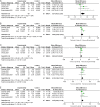Effects of whole-body vibration on chronic ankle instability: a systematic review
- PMID: 38222746
- PMCID: PMC10783336
- DOI: 10.1097/MS9.0000000000001510
Effects of whole-body vibration on chronic ankle instability: a systematic review
Abstract
Background and objective: Chronic ankle instability (CAI) is one of the most common sports injuries, and whole-body vibration (WBV) training has been used lately as a potential rehabilitation modality for these patients. The authors conducted a systematic review and meta-analysis to assess whether WBV training positively affects patients with CAI.
Materials and methods: The authors systematically searched four databases, including MEDLINE (PubMed), Scopus, Web of Science, and Cochrane Central Register of Controlled Trials, for randomized and non-randomized trials evaluating the effects of WBV on individuals with CAI. The authors used Cochrane RoB2 to assess the risk of bias in randomized trials. A meta-analysis was conducted if three or more studies measured the same outcome. Effect estimates were pooled using a random-effects model.
Results: Results were retrieved from seven articles encompassing 288 participants who had CAI. The reach distance of the Star Excursion Balance Test (SEBT) was regarded as the study's main finding. The authors saw a significant training effect on certain planes of motion on dynamic balance. The findings showed that the post-intervention measurements in the WBV group compared to control groups showed improvements in the posterolateral, posteromedial, and medial directions, respectively. There were also promising results on improvements in muscle activity, strength, and proprioception sense measurements with a great diversity in the reported parameters.
Conclusion: The authors observed a significant WBV training effect on dynamic balance over posterolateral, posteromedial, and medial reach distances. These findings suggest future studies on the effects of WBV on muscle activity, strength, and proprioception in addition to dynamic and static balance.
Keywords: ankle injuries; chronic ankle instability; ligament; postural balance; whole-body vibration.
Copyright © 2023 The Author(s). Published by Wolters Kluwer Health, Inc.
Conflict of interest statement
The authors have no conflicts of interest to declare.Sponsorships or competing interests that may be relevant to content are disclosed at the end of this article.
Figures
Similar articles
-
The effect of the combination of whole body vibration and shoe with an unstable surface in chronic ankle instability treatment: a randomized clinical trial.BMC Sports Sci Med Rehabil. 2021 Mar 19;13(1):28. doi: 10.1186/s13102-021-00256-6. BMC Sports Sci Med Rehabil. 2021. PMID: 33741051 Free PMC article.
-
Acute effects of whole-body vibration on ankle motion smoothness in individuals with chronic ankle instability.J Bodyw Mov Ther. 2024 Oct;40:1115-1122. doi: 10.1016/j.jbmt.2024.07.035. Epub 2024 Jul 16. J Bodyw Mov Ther. 2024. PMID: 39593422 Clinical Trial.
-
Whole-Body-Vibration Training and Balance in Recreational Athletes With Chronic Ankle Instability.J Athl Train. 2018 Apr;53(4):355-363. doi: 10.4085/1062-6050-547-16. Epub 2018 Mar 23. J Athl Train. 2018. PMID: 29569943 Free PMC article. Clinical Trial.
-
Does Strength Training for Chronic Ankle Instability Improve Balance and Patient-Reported Outcomes and by Clinically Detectable Amounts? A Systematic Review and Meta-Analysis.Phys Ther. 2021 Jul 1;101(7):pzab046. doi: 10.1093/ptj/pzab046. Phys Ther. 2021. PMID: 33517464
-
Rebuilding Stability: Exploring the Best Rehabilitation Methods for Chronic Ankle Instability.Sports (Basel). 2024 Oct 17;12(10):282. doi: 10.3390/sports12100282. Sports (Basel). 2024. PMID: 39453248 Free PMC article. Review.
Cited by
-
Effects of acupuncture combined with strength training and whole-body vibration training on patients with chronic ankle instability: a randomised controlled trial.Front Bioeng Biotechnol. 2025 Aug 8;13:1615121. doi: 10.3389/fbioe.2025.1615121. eCollection 2025. Front Bioeng Biotechnol. 2025. PMID: 40861850 Free PMC article.
-
Stress fracture risk factors in soccer players: A systematic review.Ann Med Surg (Lond). 2025 Apr 2;87(6):3736-3747. doi: 10.1097/MS9.0000000000003136. eCollection 2025 Jun. Ann Med Surg (Lond). 2025. PMID: 40486656 Free PMC article. Review.
References
-
- Doherty C, Delahunt E, Caulfield B, et al. The incidence and prevalence of ankle sprain injury: a systematic review and meta-analysis of prospective epidemiological studies. Sports Med 2014;44:123–140. - PubMed
-
- Gutierrez GM, Kaminski TW, Douex AT. Neuromuscular control and ankle instability. PM R 2009;1:359–365. - PubMed
Publication types
LinkOut - more resources
Full Text Sources



